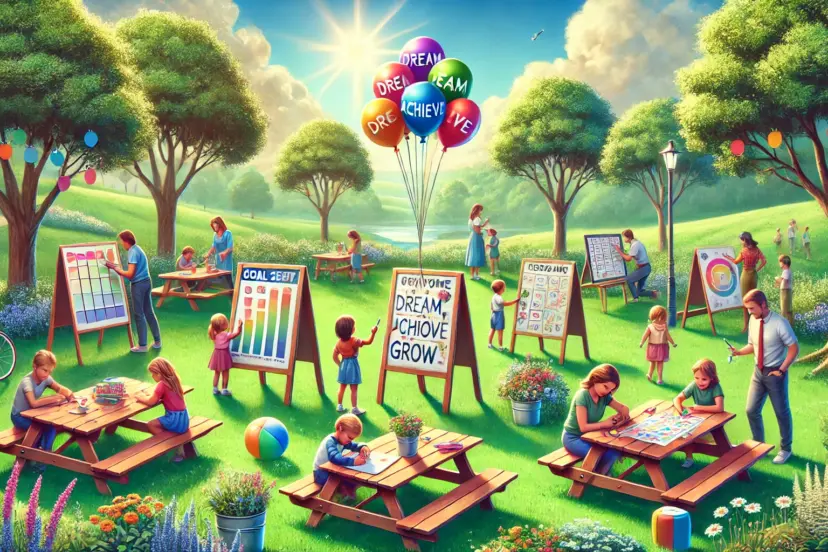Goal Setting for Kids: A Fun and Simple Guide to Success
We may earn a commission for purchases made using our links. Please see our disclosure to learn more.
Giving children a treasure map is similar to teaching them how to develop goals. It gives them focus, direction, and the resources they need to accomplish something worthwhile. However, how can goal-setting be made interesting and productive for kids? Together, let’s embark on this fascinating adventure and assist children in realizing their full potential!
Why Is Goal Setting Important for Kids?
Children who develop goals feel more directed and purposeful. It teaches children how to cultivate self-discipline, recognize successes, and work for something significant. They could feel like a sailor lost at sea if they have no ambitions. A route to success is created by assisting them in defining their goals and how to reach them.
What Makes a Good Goal?
A excellent aim is attainable, precise, and unambiguous. Imagine it as a strong ladder, with each rung leading them closer to their goals. Clear objectives help children keep focused and monitor their progress. For instance, rather than saying, “I want to be better at art,” an excellent aim may be, “I will draw one picture every day for two weeks.”
The Power of Writing Goals Down
Children commit to themselves when they put their aspirations in writing. Keeping their objectives in plain sight, such as on the refrigerator or in a notepad, acts as a daily reminder. Additionally, goals feel more concrete and attainable when they are put in writing. It’s similar to transforming ideas into a step-by-step road map.
SMART Goals for Kids
Children can develop well-considered and realistic goals with the aid of the SMART framework. To avoid misunderstandings, goals must to be clear and quantifiable so that advancement can be monitored. In order to establish a sense of urgency, they should also be attainable, pertinent to the child’s interests, and time-bound. This framework transforms intangible concepts into plans that children can confidently follow.
Start Small, Dream Big
Big dreams can feel overwhelming, so it’s important to break them into smaller, manageable tasks. For instance, if your child wants to learn to swim, they can start with practicing floating before attempting strokes. This approach makes the journey less daunting and teaches kids that small steps eventually lead to big accomplishments.
The Role of Parents and Guardians
Parents and guardians play a key role in guiding kids through the goal-setting process. You’re not there to set the goals for them but to offer encouragement, advice, and support. Think of yourself as a coach on the sidelines, cheering them on and helping them navigate challenges. This balance ensures the goals remain personal and meaningful to your child.
Make Goal Setting Fun
Goal setting doesn’t have to feel like homework—it can be a fun activity! Create colorful goal charts, use stickers to track progress, or celebrate milestones with small rewards. By turning it into a game, you make the process engaging and exciting, ensuring kids stay motivated to pursue their goals.
Overcoming Obstacles
Every journey has bumps along the way, and kids will face challenges too. When they encounter setbacks, it’s an opportunity to teach resilience and problem-solving. Help them see obstacles as puzzles to solve, not walls to stop them. This mindset builds confidence and determination to keep going, even when things get tough.
Visualize Success
Visualization is a powerful tool that helps kids imagine achieving their goals. Encourage them to close their eyes and picture the moment they succeed. What does it look like? How do they feel? This practice boosts their confidence and makes their goals feel more real and attainable.
Celebrate Milestones
Every step forward is worth celebrating. Whether it’s completing their first book or mastering a new skill, take a moment to acknowledge their progress. Celebrations can be simple, like a high-five or a favorite treat, but they reinforce the idea that effort leads to rewards and keeps motivation high.
Learning from Failure
Failure isn’t the end—it’s a stepping stone to success. When kids don’t reach a goal, encourage them to reflect on what went wrong and what they can do differently next time. This helps them develop a growth mindset and see failure as a natural part of the learning process, not something to fear.
Incorporate Rewards Wisely
Rewards can be a great motivator, but they should be balanced. Focus on helping kids appreciate the intrinsic rewards of achieving their goals, like the pride and confidence they feel. External rewards, like a fun outing or a small gift, can be occasional treats to celebrate bigger milestones.
Teach Time Management
Time management is a critical skill for achieving goals. Help kids create a daily schedule or use visual tools like timers and calendars to stay organized. Teaching them how to prioritize tasks ensures they have enough time to work on their goals without feeling overwhelmed.
Role Models Matter
Kids learn a lot by watching the adults in their lives. Share your own goals with them and talk about how you’re working toward them. Seeing your dedication and persistence inspires kids to approach their goals with the same enthusiasm and determination.
Make It a Family Affair
Setting family goals can be a wonderful way to bond and work together. Whether it’s saving for a vacation, planting a garden, or cooking a new recipe, shared goals show kids the power of teamwork. It also reinforces that everyone has something to contribute toward a common objective.
Reflect and Adjust
Sometimes, goals need to be tweaked or even replaced, and that’s okay. Encourage kids to regularly review their progress and evaluate if their goals still align with their interests. This flexibility helps them stay engaged and ensures their goals remain relevant and exciting.
Turn Setbacks Into Stepping Stones
Setbacks are like detours on a road trip—they’re inconvenient but not the end of the journey. Teach kids to view challenges as opportunities to learn and grow. This perspective keeps them motivated and shows them that every stumble is a chance to build resilience.
Tools and Resources for Kids
Using tools like journals, apps, or vision boards makes goal setting interactive and fun. Let kids decorate their resources to reflect their personalities and interests. These tools help kids visualize their goals and track their progress in a way that feels engaging and personal.
Encourage Peer Support
Having a buddy can make goal setting more enjoyable. Encourage kids to share their goals with friends or classmates who can cheer them on. Peer support not only boosts accountability but also fosters a sense of camaraderie and shared achievement.
The Long-Term Benefits of Goal Setting
Learning to set goals early in life builds habits that last a lifetime. Skills like planning, self-discipline, and adaptability prepare kids for challenges in school, work, and beyond. By teaching them to aim high and stay focused, you’re equipping them with tools for a successful future.
A Goal-Setting Activity to Try
A great activity to try is creating a “Goal Ladder.” Draw a ladder with the goal at the top and steps leading up to it. Each rung represents a small, actionable step that brings them closer to their target. It’s a visual and interactive way to break big goals into manageable tasks.
The Science Behind Goal Setting for Kids
Research highlights the transformative impact of goal setting on children’s growth and success. A comprehensive review titled Student Goal Setting: An Evidence-Based Practice reveals that goal setting significantly enhances students’ intrinsic motivation, agency, and self-management skills, fostering better learning outcomes. Similarly, a study published in Psychology Today emphasizes that children who develop goal-setting habits are more likely to excel academically and in their personal lives. These findings underscore the value of teaching kids how to set and achieve meaningful goals.
Recommended Goal-Setting Resources for Kids
Introducing children to goal-setting can be both educational and enjoyable with the right tools. Here are some highly recommended resources available on Amazon:
- Goal Setting Journal for Kids: This journal is designed to nurture an attitude of achievement and success in children. It provides space for over 150 goals, allowing kids to break each one into actionable steps. It’s versatile for setting various goals, from school to home activities.
- The Little Book of Setting Goals: Aimed at children aged 3 to 10, this book introduces the concepts of goals, aspirations, planning, hard work, and accomplishments in a kid-friendly manner. It’s an excellent resource for teaching young ones how to identify priorities and work towards achieving them.
- Ambitious Ninja: A Children’s Book About Goal Setting: Part of the Ninja Life Hacks series, this book teaches children about the importance of setting goals and persevering to achieve them. It’s a fun and engaging way to introduce goal-setting concepts to young readers.
- Good Habits and Goal Setting for Kids: An Activity Book and Journal: This activity book is designed to teach children essential life skills, including goal setting and the development of good habits. It offers various exercises and prompts to make learning these skills interactive and fun.
FAQs About Goal Setting for Kids
- What age should kids start setting goals?
Kids can start as early as 4 or 5 with simple goals, like tying their shoes or cleaning up toys. As they grow, their goals can become more complex. - How do I keep my child motivated?
Celebrate their progress, keep goals visible with charts or notes, and make the process fun with rewards or games. Encouragement goes a long way. - What if my child loses interest in a goal?
Help them reflect on why they set the goal in the first place. If it no longer resonates, guide them to adjust it or choose a new one that excites them. - Can goal setting help with school performance?
Yes, setting goals like completing homework on time or studying for 20 minutes a day helps kids develop focus, discipline, and academic success. - How often should we review goals?
Regular check-ins, like weekly or monthly, help track progress and ensure goals remain relevant. Adjustments can be made during these reviews as needed.
Conclusion
Goal setting is a valuable life skill that empowers kids to take charge of their futures. By teaching them how to set, pursue, and achieve goals, you’re giving them the tools to dream big and work hard. Start today, and watch their confidence and abilities soar!




